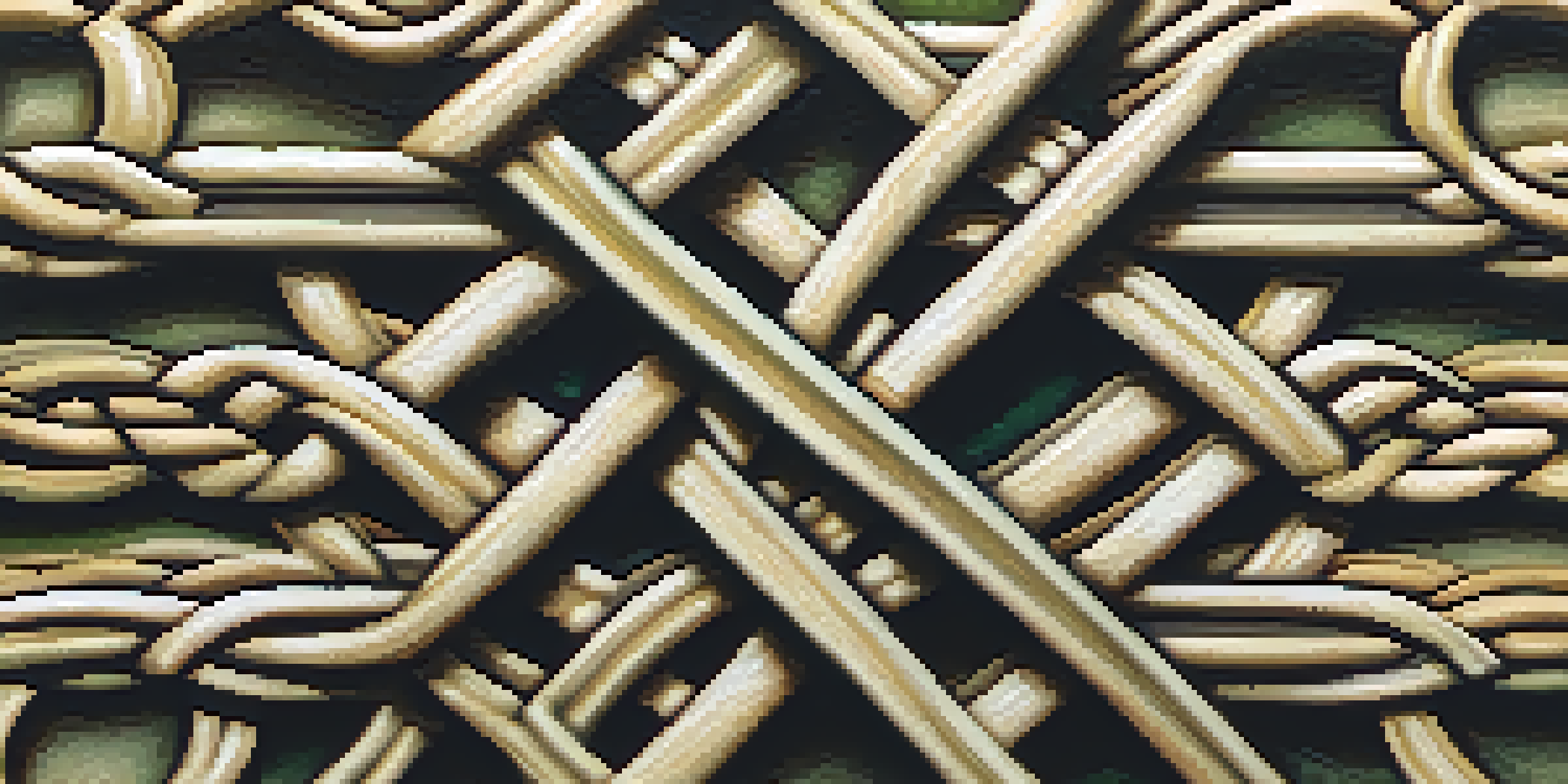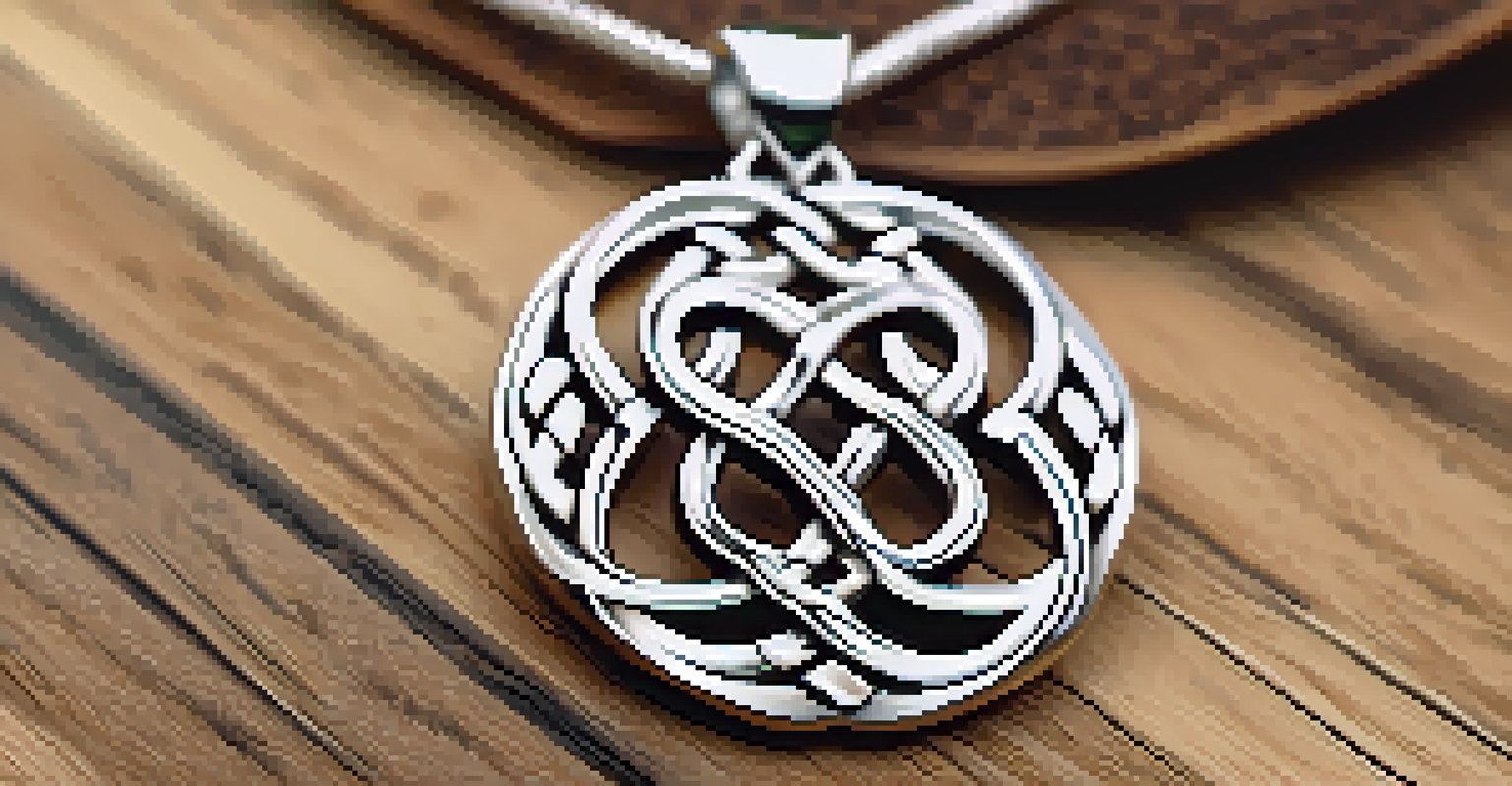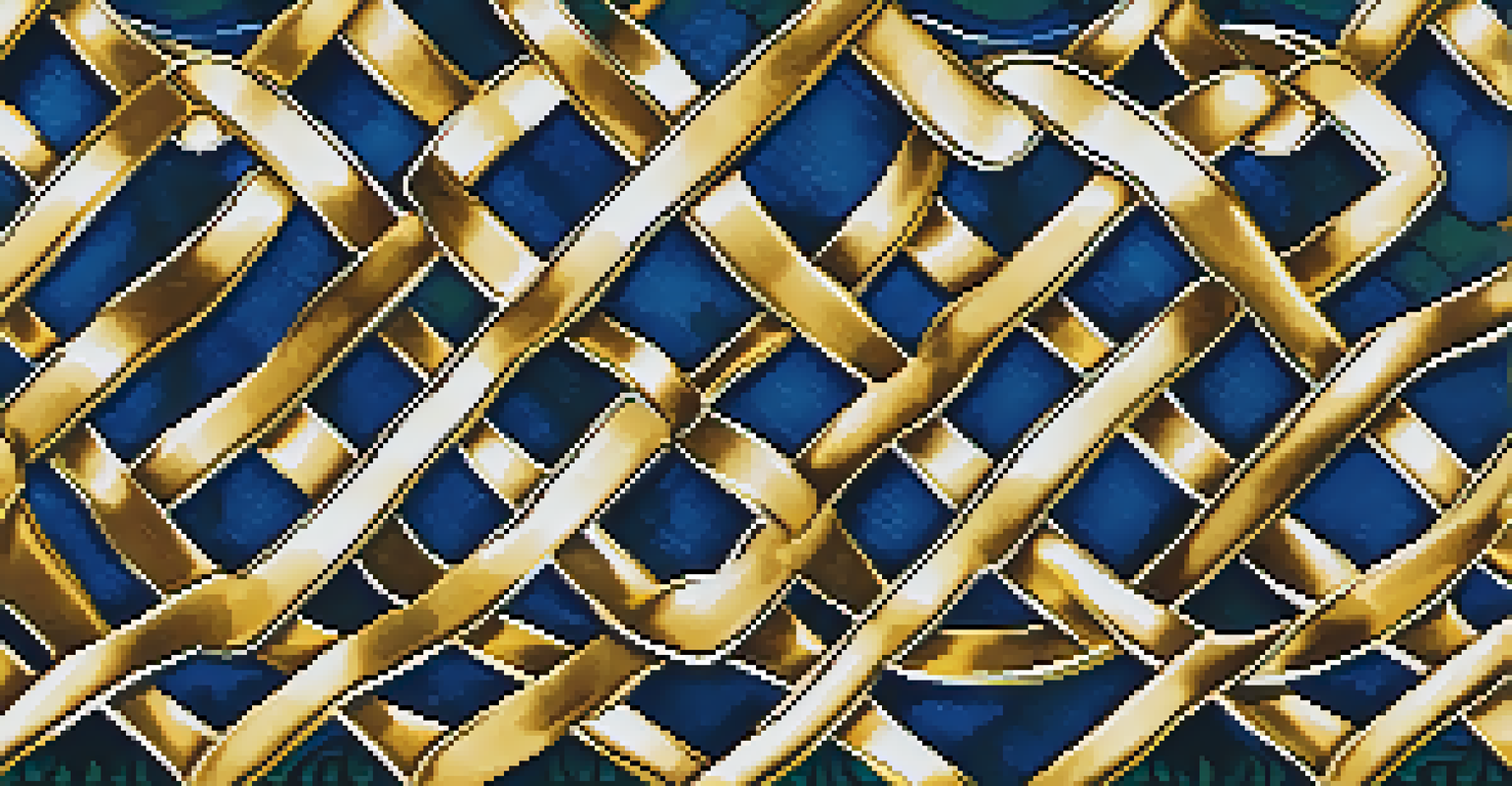Celtic Knots: Carving Stories in Ancient Irish Culture

The Origins of Celtic Knots in Ancient Ireland
Celtic knots trace their roots back to early Irish art, where they served as a visual expression of spirituality and culture. These intricate designs often appeared in manuscripts, jewelry, and stone carvings, acting as a bridge between the earthly and the divine. The earliest examples can be found in the Book of Kells, a stunningly illustrated manuscript dating back to the 9th century.
The beauty of Celtic knots lies not only in their intricate designs but in the deep meanings they convey, connecting us to our past and the universe.
The patterns consist of interwoven lines that have no beginning or end, symbolizing eternity and the interconnectedness of life. This concept resonates deeply within ancient Irish beliefs, where the cyclical nature of existence was revered. The knots also reflect the complex social structures of Celtic society, hinting at the importance of community and relationships.
As you delve into the history of Celtic knots, you’ll find that these designs were not just decorative; they were imbued with meaning. Each twist and turn tells a story, representing ideas such as love, loyalty, and the journey of the soul. This rich tapestry of symbolism continues to captivate and inspire modern audiences today.
Symbolism Behind the Intricate Designs
Celtic knots are more than just pretty patterns; they are laden with symbolism that reflects the core values of ancient Irish culture. For instance, the endless loops signify eternity and the cyclical nature of life, while the interconnectivity of the lines illustrates the idea that everything in life is related. This perspective encourages a sense of unity and belonging, which was essential for the closely-knit Celtic communities.

Different knot styles carry unique meanings as well. The trinity knot, for example, represents the Holy Trinity in Christianity but also reflects the pagan belief in the triad of life: birth, death, and rebirth. Such layers of meaning give each design a depth that invites contemplation and personal interpretation.
Celtic Knots Symbolize Eternity
The intricate designs of Celtic knots represent eternity and interconnectedness, reflecting ancient Irish beliefs about life and community.
Moreover, these symbols often served as a form of storytelling, encapsulating tales of heroism, love, and the natural world. For many, wearing or displaying a Celtic knot is a way to connect with their heritage and honor the stories of their ancestors. This blend of personal and cultural significance makes Celtic knots timeless treasures.
The Role of Nature in Celtic Knot Design
Nature plays a pivotal role in the designs of Celtic knots, reflecting the deep connection ancient Irish people had with their surroundings. The curves and patterns often mimic the organic shapes found in flora and fauna, serving as a reminder of the beauty and complexity of the natural world. This harmonious relationship is integral to the Celtic worldview, where nature was seen as a manifestation of the divine.
Art is the most beautiful of all lies; it is a reflection of our deepest truths.
Artists and craftsmen would observe the intricacies of tree roots, vines, and animals, translating these forms into their artwork. The resulting knots are not just arbitrary; they are celebrations of the environment, echoing the cycles of seasons and life. This close observation of nature enriched the designs, adding layers of meaning that resonate with those who appreciate the artistry.
Furthermore, the reverence for nature is evident in how Celtic knots are often used to represent the elements, such as earth, air, fire, and water. Each element embodies different qualities, and the knots serve as a reminder of the balance required to maintain harmony within oneself and the world. By embracing nature in their art, the Celts instilled a sense of responsibility toward the environment in their cultural narratives.
Celtic Knots in Ancient Manuscripts
Celtic knots are prominently featured in ancient manuscripts, where they were used to embellish texts and illuminate stories. The Book of Kells, one of the most famous examples, showcases magnificent illustrations filled with intricate knotwork. These designs not only beautified the pages but also served as markers of significance, guiding the reader's attention to important passages.
The use of knots in manuscripts signifies the sacredness of the written word in Celtic culture. Each knot could represent a spiritual journey or a connection to the divine, inviting readers to engage with the text on a deeper level. This interplay between art and scripture reflects the high regard the Celts had for both storytelling and visual expression.
Nature Inspires Knot Designs
Celtic knots are deeply influenced by the natural world, mirroring organic forms and emphasizing the Celts' profound connection to their environment.
Additionally, these manuscripts were often created in monasteries by skilled scribes who had a profound understanding of both the art and the message they were conveying. The combination of text and knotwork created a unique form of storytelling that transcended mere words, allowing the reader to experience the narrative visually and spiritually.
Celtic Knots in Jewelry and Ornamentation
Celtic knots have transcended time and space, finding their way into jewelry and ornamentation that continues to resonate today. From intricate rings to elegant pendants, these designs are often worn as symbols of love, loyalty, and friendship. The timeless appeal of Celtic knot jewelry lies in its ability to convey deep meaning while also offering aesthetic beauty.
Artisans craft these pieces with care, ensuring that each knot is a reflection of both skill and intention. The act of wearing a Celtic knot is not just about fashion; it’s about embodying the values and stories that have been passed down through generations. Many people choose these pieces as meaningful gifts, celebrating milestones and connections with loved ones.
Moreover, the revival of interest in Celtic knots in modern design demonstrates their enduring relevance. Today, many individuals seek out these symbols as a way to connect with their heritage or to express their personal beliefs. Whether it’s a wedding band or a simple charm, Celtic knot jewelry allows people to carry a piece of their history with them, making it a powerful statement of identity.
Modern Interpretations of Celtic Knots
While rooted in ancient tradition, Celtic knots have evolved to fit modern aesthetics and sensibilities. Contemporary artists and designers are reimagining these intricate patterns, incorporating them into everything from textiles to home decor. This modern twist not only preserves the significance of the knots but also introduces them to new audiences.
Many modern interpretations maintain the core symbolism associated with Celtic knots, while infusing them with fresh ideas and styles. This blend of tradition and innovation allows these designs to resonate with younger generations, who may feel a connection to their heritage in new and exciting ways. The versatility of Celtic knots ensures that they remain relevant in today’s artistic landscape.
Legacy of Celtic Knots Endures
Today, artisans and educators work to preserve the cultural significance and craftsmanship of Celtic knots for future generations.
Additionally, the resurgence of interest in handmade and artisanal products has led to a renewed appreciation for the craftsmanship involved in creating Celtic knots. Whether through woodworking, metalwork, or textile art, the dedication to preserving this craft is evident in the quality and intention behind each piece. As a result, Celtic knots continue to carve out their place in both history and modern culture.
Preserving the Legacy of Celtic Knots Today
As we appreciate the beauty and significance of Celtic knots, it’s crucial to consider how we can preserve this rich cultural heritage for future generations. Many artisans today are committed to using traditional methods and materials, ensuring that the craft remains authentic. By supporting these creators, we help sustain the artistry and stories that these knots represent.
Educational initiatives also play a vital role in keeping the legacy alive. Workshops and community programs often focus on teaching the skills needed to create Celtic knots, fostering a new generation of artists and enthusiasts. These efforts not only empower individuals to connect with their heritage but also promote a sense of pride in Irish culture.

Ultimately, the legacy of Celtic knots is not just about the designs themselves but the stories they carry. By sharing these stories and celebrating the artistry behind them, we can ensure that the magic of Celtic knots continues to inspire and resonate for years to come. It’s a collective responsibility to honor this heritage and keep the spirit of the Celts alive.